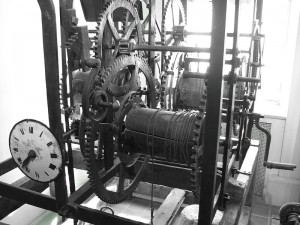Once the hero has experienced the Epiphany (in which he finally realizes how he has a chance to defeat a seemingly undefeatable adversary), the novelist must make speed of the essence.
An author cannot allow her hero the luxury of time to resolve his issue and/or defeat the antagonist. The time allowed the hero to complete his critical task must be limited.
A clock should now be ticking.
Think about movies scenes in which the hero needs to defuse an explosive device. A clock literally ticks away the seconds to detonation. The hero (and the audience) is sweating bullets. That is the kind of tension a well-paced showdown and resolution ignites.
Some examples:
- In the Hunger Games, Katniss and Peeta have grown to love each other, but the sadistic rules of the gladiatorial style combat to which they were recruited now force them to fight each other to the death.
- In The Graduate, Benjamin must rush to the church to interrupt Elaine’s wedding to the wrong guy. Will he get there in time?
- In Star Wars, Luke only has a limited time to hit the Death Star at its vulnerable point.
- In Bridget Jones’s Diary, Bridget’s Mr. Right (Mark) is leaving Britain with his fiancee (not Bridget) to accept a job in New York. Bridget must find a way to get Mark back – and soon.
- In The Fugitive Kimble confronts both Sykes, the hired killer, and the real killer, Nichols, who can exonerate him of the false accusation that he murdered his wife – but just ss Kimble does so, the law closes in him.
Once the author sets up the reason Speed Is Now of the Essence, the hero rushes to his Showdown with the antagonistic force – and the Resolution of the story. We’ll look at the Showdown and Resolution in the next blog post.
Happy writing!
Watch Jessica Hatchigan’s video tutorial – “How Bestselling Authors Create Pageturner Novels: Plot & Structure ” instantly on your PC, Mac, compatible TV or device via Amazon.com’s instant video


No Comments